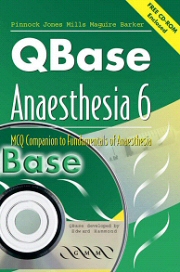Clinical Anaesthesia
from Section 1 - Questions
Published online by Cambridge University Press: 05 October 2015
Summary
Q 1. Signs of increasing intracranial pressure may include
A. Decreasing level of consciousness
B. Hypotension
C. Small pupils
D. Tachycardia
E. Rhinorrhoea
Q 2. Which of the following are correct
A. Vagus nerve innervates the epiglottis
B. Recurrent laryngeal nerve gives the motor supply to the abductors of the vocal cords
C. Median nerve supplies the outer 3½ fingers
D. Subclavian vein is posterior to the artery
E. Subarachnoid space ends at L2
Q 3. In a patient with a recent head injury the following are indications for immediate surgery
A. Depressed skull fracture
B. Extradural haematoma
C. Subdural haematoma
D. CSF rhinorrhoea
E. Hydrocephalus
Q 4. DC cardioversion may be indicated in
A. Ventricular tachycardia
B. Premature atrial contractions
C. Atrial flutter
D. Digitalis toxicity
E. Supraventricular tachycardia
Q 5. Which of the following nerves supply the intrinsic muscles of the larynx
A. Internal laryngeal
B. Hypoglossal
C. Those originating in the nucleus ambiguus
D. Recurrent laryngeal
E. Glossopharyngeal
Q 6. Deep venous thrombosis (DVT) is more common in
A. Elderly patients
B. Patients with malignant disease
C. Patients with cardiac failure
D. Patients receiving dextrans
E. Patients on hormone replacement therapy
Q 7. The following ECG changes are seen with hyperkalaemia
A. Loss of p wave
B. Widening of QRS
C. VF
D. Increased size of T wave
E. Increased size of U wave
Q 8. In a pressure cycled ventilator
A. The cycling pressure is determined by the patients compliance
B. The inspiratory time is fixed
C. It is a minute volume divider
D. The expiratory period may be time cycled
E. The tidal volume is fixed
Q 9. Regarding statistics
A. The middle observation in an ordered series is a median
B. The mean is the most frequently occurring observation in a series
C. Standard deviation gives an indication of the scatter of Observations
D. 95% of all observations should lie within ±2 standard deviations
E. Standard deviation is a measure of the significance of observations
Q 10. Regarding statistics
A. The standard deviation is the square root of the variance
B. The standard deviation is less than the standard error
C. A type I error occurs when the null hypothesis is rejected when it is true
D. The power of a study is defined as 1_ type II error rate
E. The student's t test can be applied to normally distributed data
- Type
- Chapter
- Information
- QBase Anaesthesia , pp. 35 - 46Publisher: Cambridge University PressPrint publication year: 2000



